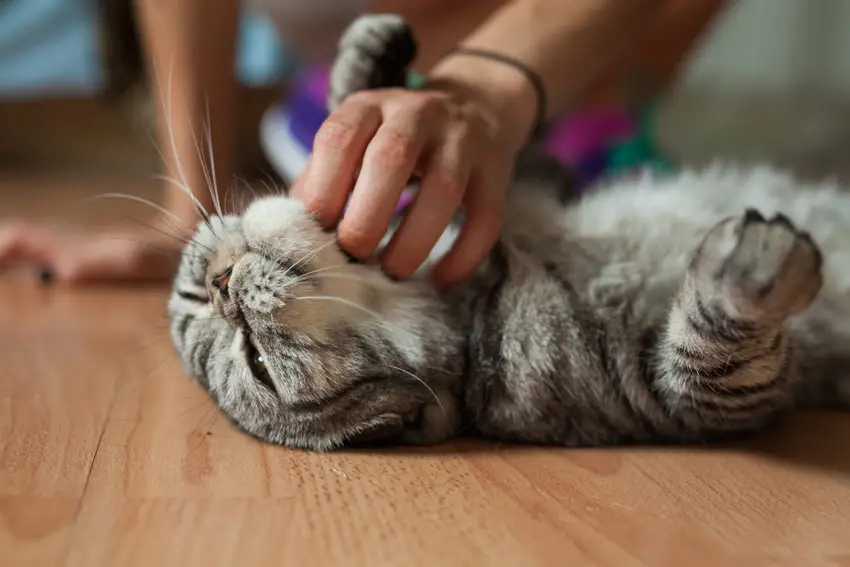
You can tickle a cat by gently touching its chest, tail, neck, chin, or ears. Avoid tickling the cat’s belly since it has thin skin.
If you would like to show some affection to your cat, you are probably thinking about tickling them. Though a cat may not laugh when you tickle them, they may respond positively or negatively depending on where you tickle them. This post can help you discover how to tickle a cat and what area to avoid as you tickle them. Enjoy!
Here is how you can tickle a cat
Just like humans, cats are ticklish. They tend to react differently to being tickled. As a cat owner, you should pay attention to the pet’s behavior every time you tickle them to determine whether they enjoy it. Here are some areas where you can tickle the cat.
The paws
Since the cat’s paws are quite sensitive, they may enjoy it when you tickle them. You can tickle the paws of a cat by touching this area softly. Most cats enjoy the sensation of their paws being tickled. However, you should avoid doing this without warning since the cat may not react positively to the gesture. For example, do not wait until the cat is asleep to tickle its paws.
Most cats that are ticklish on the paws are young since they are more sensitive to touch than older cats.
Back
Apart from the paws, you can also tickle this pet on the back. Cats enjoy being tickled in this area since it has more fur and does not have too many nerve endings. You can tell a cat likes being tickled along its back if it enjoys being groomed in this area. Do not tickle the cat’s back for so long due to the risk of overstimulation. If you notice that your pet does not like its back being touched, do not try to tickle them.
Chin
You can also tickle a cat under its chin since this area also has sensitive skin. If you tickle the chin of a cat, it may begin purring. This indicates that the cat is happy and enjoying the tickle.
Head
The head is also a great spot to tickle a cat. If, for instance, you were tickling the cat’s chin, you may notice it lifting its head. This indicates that they enjoy the sensation and want to be tickled on the neck.
Apart from the neck, you can also tickle the cheeks. This is a great spot to tickle the cat since it contains multiple scent glands. The cat can even transfer its scent to you as you tickle them on the head. While some cats enjoy being tickled on the ears, others don’t. The base of a cat’s ears is more welcoming than tickling the top or middle part of the ears.
If you are not sure whether the pet will enjoy being tickled on the ears, you can begin with behind the ears. See how the pet responds to the tickle before you continue.
Chest
Some cats also enjoy being tickled on the chest. One of the signals that can help you find out if the cat likes being tickled on the chest includes raising its head up. If the cat likes this, you may also notice it lying on its back for you to tickle the chest area.
Tail
You can also tickle a cat on its tail. This area contains different nerves that could lead to an intense sensation when tickled. For the cat to enjoy the tickle on its tail, you have to do it right. If you notice the cat lifting its butt every time you tickle the tail, it means that they are enjoying it.
If you notice the cat moving its tail from side to side every time you try to tickle it, you should stop touching it since this means that the cat is not enjoying the tickle. Some cats don’t like their tails being tickled and always move away from the person doing the tickling.
Why you should avoid tickling a cat on its belly
The cat’s belly is extremely sensitive to touch. You should avoid tickling the belly since this may cause discomfort or even pain in some cats. The belly is the part that requires the most protection in a cat since it has thin skin. If a cat shows it’s belly, it means that it trusts you. You should, however, avoid tickling this part since the cat may attack you.
How a cat reacts to being tickled
Purring |
When a cat purrs as you tickle them, it shows that they are happy. |
Meowing |
Short and high-pitched meows during tickling are a good sign. |
Licking |
You may notice the cat licking your hand when you tickle a particular part. This is a sign of appreciation from the cat. |
Tense body |
If a cat suddenly becomes tense as you tickle them, it means that they are uncomfortable. |
Growling |
If the pet growls when you tickle them, it means that they are preparing to attack you. |
Conclusion
Stimulating the nerve receptors of a cat can cause a particular sensation. When you tickle a cat, it may react in some of the ways we have highlighted in the table above. As you tickle the cat along the different areas we have discussed, you should know when to stop. Avoid tickling the cat for so long since they may stop enjoying it. Long tickling sessions are also not good for the cat’s skin since they can cause discomfort or itchiness.
FAQs
Can a cat laugh when tickled?
No. Cats are not like humans, so they cannot laugh when you tickle them. They, however, produce certain noises to express how they feel.
What does it mean when my cat swipes at me as I tickle her?
This shows that the cat is ready to attack you. If you notice the cat swiping it’s paw at you, you should stop tickling them immediately to avoid annoying her.


